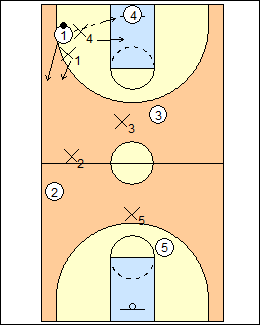Fullcourt man-to-man basics
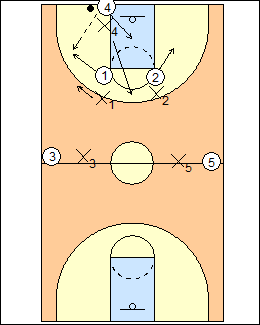 | 1 40 is fullcourt man-to-man defence without trapping, 42 has trapping. Even basic fullcourt pressure can dictate tempo, turn up your aggressiveness, and wear down the other team, especially their point guard. Progressions: 40 1) On (up on the inbounder) - Basic press - pick up checks fullcourt - Tough - deny an inbounds pass, look for a 5-second count 2) Shortstop - double-team deny a good point guard 3) Off (Rover) - face-guard primary receivers. 42 1) Quick trap - on the inbounds pass 2) Trap off the dribble - trap with X4, or trap from the front 3) 42 tough - down late in a game, try for steals, the press stays on. To keep the ball away from a good point guard, deny an inbounds pass or trap then deny when they give up the ball. 40 1) On X4 gets up on the inbounds passer. a) Basic press Play behind primary receivers, allow an inbounds pass. X4 drops to the line of the ball on an inbounds pass, then it's basic fullcourt pressure, without trapping, X4 is the help to contain the ball. Avery Johnson - don't get in front of your man and invite an overhead pass, no long passes. Breakthrough Basketball - light fullcourt pressure can be more disruptive and annoying than hard fullcourt pressure. Don't worry about turning the dribbler, just be close enough to disrupt any quick change of direction and make him feel uncomfortable. If a pass is made upcourt, everybody sprints back and matches up. Eddie Andrist - Run and Jump Press - you do not need to steal the ball, you want the offence to make mistakes. X1 and X2 do not deny an inbounds pass, they stay behind 1 and 2 allow a catch in front. X3 and X5 are in a side position, not total denial or behind.  |
 | b) 40 Tough Deny an inbounds pass, look for a 5-second count. X4 is on the inbounder but can shade middle. Defenders of primary receivers deny from the inside, sending receivers to the baseline, and switch or gap on a screen. On an inbounds pass, pressure and turn the ball, deny away from the ball. Breakthrough Basketball - for a basic fullcourt press, extend your man-to-man defence to fullcourt, except you will most likely be denying most passes. With youth teams don't worry about trapping. Switch on screens, or have the screen defender take a couple of steps back to let the cutter defender through and still deny. Eric Flannery - Fullcourt Press Concepts - X1 and X2 stay on inside shoulders (square to the passer), don't allow a catch in the middle of the floor, make them catch going towards the corners if you can. Morgan Wootten - deny passes all over the court, needed when trailing at the end of a game to force a turnover. X1 turns the dribbler, nose on the ball. Canada Basketball - good presses must influence the ball in specific directions. Renato Pasquali - pick up the ball at the foul line, all other defenders should be in the passing lanes, force the ballhandler to change direction as often as possible, and don't allow him to determine which side to dribble to. Once he crosses halfcourt, keep the ball on that side, creating a ballside and helpside. See Defences - Morgan Wootten fullcourt, George Mason Scramble fullcourt, Billy Tubbs fullcourt man, also White and Black matchup press.  |
 | 2) Shortstop To deny an inbounds pass to a strong point guard, X4 double teams with X1. X4 face guards but gaps, X1 plays 3/4 from the middle, not allowing a pass over the top. On an inbounds pass to another attacker, X4 recovers to 4 (line of the ball) and X1 denies 1. If 1 inbounds the ball, go 40 On, X1 defends the inbounds passer then denies a return pass. Wootten - Shortstop - X4 plays between the ball and 1, X1 plays behind and ballside, completing the double team. George Mason - Twist - as the ball is taken out by 4, X4 double teams by face guarding 1. Twist is great after a time-out, and a terrific way to get a 5-second violation. Bob Hurley - against a team that runs on made field goals, instead of guarding the inbounder, double the outlet, forcing him to go back for the inbounds pass, you've taken away the break. Doug Porter - Off press - the inbound defender double-teams the best ballhandler to force the ball to other players, or against a 1-up press break. 3 on 3 on 3 Flavell - X1 plays behind 1, X4 face guards and denies. Also play behind a second primary receiver, pushing them down to the baseline, allowing a catch in front (then force sideline).  |
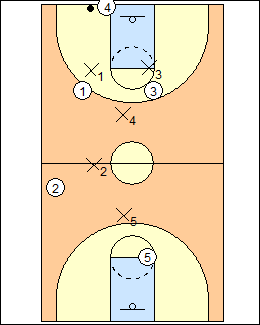 | 3) Off (Rover) X4 drops off the inbounds passer, playing in a rover position behind the primary receivers, X1 and X3 deny, trying for a 5-second count. A long safety (e.g. X1) could be the rover if their check is closest to the ball and inbounds. Wootten - Centerfield - X4 plays at or above the top of the circle, cheating ballside, X1 and X3 can be even more determined about overplaying because a lob is covered. Jim O'Brien - the black press is used after a made perimeter shot or on a dead ball, instead of pressuring the inbounder, X4 supports behind the front line of the press. Chris Oliver - full denial option - X4 is the safety, he covers the deep inbounds pass, everyone else face guards, switches everything, and doesn't look at the ball. See Defences - Morgan Wootten (Centerfield, Leftfield), White and Black (Black), Hoop Tactics (Shadow), Hurley 2-1-2.  |
 | 42 1) Quick trap X4 immediately traps on a ballside inbounds pass (below the block). Billy Donovan - an inbounds pass ballside below the block is an automatic trap by X4. George Mason - Quick trap - the short corner is the trapping area, It's one trap then back if the press is broken. Doug Porter - X4 pressures the inbounder then looks to trap first pass. O'Brien - the white press is usually used after a score from inside the lane, X4 pressures the inbounder and immediately traps an inbounds pass to the coffin corner. Billy Tubbs - trapping is normally optional but can be required, if you don't trap the inbounds pass they will clear out. Bob Hurley - on an inbounds pass in the corner near the baseline, run a player over to trap. Flavell - X1 plays behind 1, allowing a catch in front, X4 double-teams on an inbounds pass (to either side). See Defences - White and Black (White), Florida match-up, George Mason Scramble (Quick trap), Morgan Wootten (Fist and fingers), Billy Tubbs, Kentucky, Hoop Tactics (Blitz trap). |
 | 2) Trap off the dribble After the inbounds pass, trap 1 off the dribble, a) Trap with X4 (designated trapper), or b) Trap from the front, with the nearest defender in the direction of the dribble. Force sideline, middle, or pressure the ball straight up. a) Trap with X4 Avery Johnson - after the inbounds pass, 4 gets to ball level, and at some point double teams with 1 (he can hit immediately on the inbounds pass). George Mason - Slow trap - X1 forces 1 to the middle, herding with X4 until a trap is formed, if 1 passes to 4, X1 denies a return pass. X4 is the official trapper, if he thinks he can trap a dribbler before halfcourt, especially secondary ballhandlers. Walberg - they don't care which way you force, X4 always turns into a trapper, he runs to trap if 1 drives up the sideline or the middle. Here if 1 passes in the air off the dribble to 4, X1 runs and jumps (switches to 4); if 1 stops, trap him. See Defences - Mavs fullcourt, George Mason Scramble (Slow trap), 2-2-1 Walberg. |
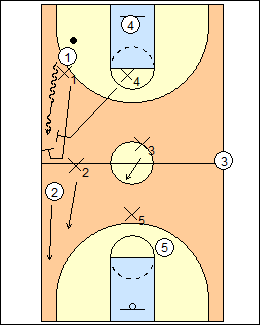 | 8 Here 1 drives up the sideline, X1 turns him (takes away the sideline) and X4 traps from the side, remaining defenders may not need to rotate. From a rover position, X4 could trap from the front (see 42 Tough). Walberg - X4 runs to trap when 1 drives up the sideline, X1 has to turn 1 and X4 traps from the side. In a trap, don't foul, and don't get split. Shaka Smart - trap the turn - X1 and X4 are going to trap, X1 takes 1 to the sideline and turns him back, X4 has to go trap once he sees the back of 1's head. Oliver - force the ball sideline then turn it back middle, trap by leaving the offensive player who clears out last. Coach Mac - Run and jump defence - the closest player defends the inbounds passer after a score (no set match-ups). Allow an inbounds pass (play behind), force sideline, trap from the blind side, run and jump switch on a middle drive. If 1 immediately reverses the ball to 4, X4 pressures the ball and X1 will trap or jump switch. Run and jump is often one-and-done. See Defences - Havoc double-fist, Trail trap, Match-up press.  |
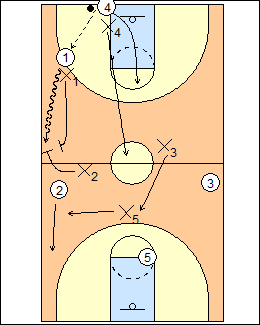 | b) Trap from the front Trap in the direction of the dribble - if 1 drives up the sideline, X2 traps from the front, X5-X3-X4 rotate to cover. O'Brien - trap with the nearest defender in the direction of the dribble, rotations are mostly instinctive, X3 or X5 can cover 2 (the obvious pass), X4 takes away a pass to the middle, the only pass not denied is backwards, all defenders are below ball level. Wootten - blitz trap - X1 can force 1 to the sideline for a trap with X2 (or a jump switch), or to the middle for a trap with X4. Donovan - X1 is not forcing side or middle, when the ball gets even with the top of the circle, another defender runs up to trap, don't allow other teams to just clear them out (also see Defences - Maryland, Kentucky). Get the ball away from the point guard, make it hard to get back. Carleton Ravens - if 1 is left-handed, X2 traps from the front and X1 takes away middle, keeping the ball on the weak hand. If 1 is right-handed, X1 turns 1 and X4 traps from the side. Shaka Smart - X1 forces sideline, most teams are smart enough to stretch 2 as 1 dribbles up the sideline, if a team doesn't have good spacing, trap up the sideline if X2 can stunt and get there in 1-2-3 strides. VCU doesn't do this as much because most teams are smart enough to stretch 2, and the guy who has to rotate (X5) is their slowest guy. Bob Hurley - with Fist, trap a dribbler in the corners, or out of control primarily up the sideline, the next defender up the sideline comes up and takes a charge (up the middle of the court, help but don't come, fake and slow him up, chase from behind, which is hard without the help). Double fist is halfcourt, trap a pass, e.g., to the best player. The first thing you want to focus on is the other point guard, confuse him, put him in situations where he loses his comfort zone, mix it up. |
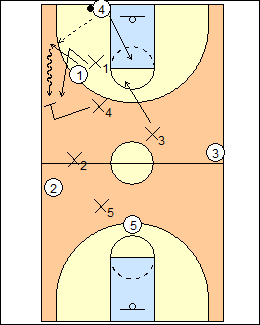 | 3) 42 Tough Try for steals, a defender looks to shoot the gap to contest a pass to the trailer out of a trap, and the press stays on for any backward pass, or keep trapping on any perimeter pass, the press is broken on a gut pass or penetrating dribble. Here rover X4 traps from the front, X3 rotates into the passing lane back to 4. Hoop Tactics - rover X4 can trap, fake a trap, or run and jump switch. See Hurley 2-1-2. O'Brien - the press stays on for any backward pass. Wootten - on a trap, take away a pass back to the inbounder. Avery Johnson - depending on time, score and spacing, a defender may be able to full rotate for a steal out of a trap, inviting a pass to the furthest attacker. Dean Smith - double-team until the ball penetrates past the hash marks in their backcourt, then sprint back, talk, pick up their men. Donovan - if the inbounder can handle the ball they will trap him, if the big is shaky, they want him to dribble and make a play at speed. If the ball is dribbled over halfcourt with no trap, the press is off, sprint to get a man. See Defences - 1-2-1-1 Basics.  |
This page was made with Basketball playbook from Jes-Soft
